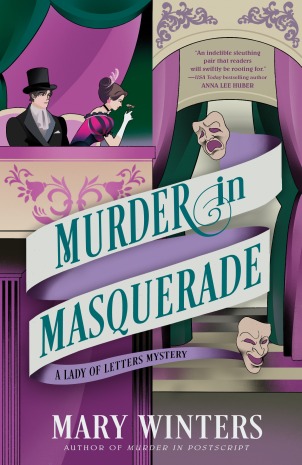 I love the theatre, so it’s not surprising that Murder in Masquerade features Royal Theatre, Drury Lane in London. I still recall my audible gasp when I saw the phantom dangling from the chandelier in Phantom of the Opera at the Orpheum Theatre in Minneapolis. How did he get up there, and how had I missed his climb? I’d been completely immersed in the story.
I love the theatre, so it’s not surprising that Murder in Masquerade features Royal Theatre, Drury Lane in London. I still recall my audible gasp when I saw the phantom dangling from the chandelier in Phantom of the Opera at the Orpheum Theatre in Minneapolis. How did he get up there, and how had I missed his climb? I’d been completely immersed in the story.
My sleuth, Lady Amelia Amesbury, is immersed in Rigoletto, the play she and Lord Simon Bainbridge attend in Murder in Masquerade, which makes keeping an eye on his sister, Lady Marielle, difficult. Lady Marielle is attending the play with a group of friends, and one man, George Davies, is a little too friendly for Simon’s taste. Simon believes Mr. Davies is using his sister to climb the social ladder and vows to keep her safe from his advances.
By the end of the play, however, Mr. Davies is missing, and it’s easy to understand how he disappeared without detection. Amid the lights, sounds, and stunts in a theatre, audience members are bound to get caught up in the action. For a few precious hours, they are transported to another place or time, and even when clues are placed before them, they can be missed by the most observant attendee.
So, too, was the case when my family and I attended a performance of Agatha Christie’s Mousetrap at St. Martin’s Theatre in London. Mousetrap opened in London in 1952 and ran continuously until 2020 when the Covid pandemic hit. Thankfully, the play reopened again in 2021 and still enjoys its designation as the longest-running play in the world. This is one time I was glad I hadn’t read a work before seeing a performance. Despite the clues, the reveal came as a surprise to me and my family. After the performance, the actors swore audience members to secrecy so that the brilliance that is Mousetrap would continue for many generations to come. My daughters, eleven and fourteen at the time, loved the play as much as I did, and I was grateful to share the experience with them.
The theatre, once again, had performed a sort of magic. It brought together people from different ages and backgrounds and transported us to another time and place. Like Simon and Amelia, we did not see the sleight of hand by the murderer. But the surprising reveal—and enjoyable time—was worth the deception.
About Mary Winters:
Mary Winters is the Edgar-nominated author of the Lady of Letters historical mystery series. Mary is also the author of two cozy mystery series and writes short fiction. Three of her short stories have appeared in Alfred Hitchcock’s Mystery Magazine. When she’s not writing, she’s teaching, reading, or spending time with her family. She lives with her husband, daughters, and spoiled pets in the Midwest. Find out more about Mary at MaryWintersAuthor.com.
Extra, extra, read all about it! Countess turned advice columnist Amelia Amesbury finds herself playing the role of sleuth when a night at the theatre turns deadly.
Victorian Countess Amelia Amesbury’s secret hobby, writing an advice column for a London penny paper, has gotten her into hot water before. After all, Amelia will do whatever it takes to help a reader in need. But now, handsome Marquis Simon Bainbridge desperately requires her assistance. His beloved younger sister, Marielle, has written Amelia’s Lady Agony column seeking advice on her plans to elope with a man her family does not approve of. Determined to save his sister from a scoundrel and the family from scandal, Simon asks Amelia to dissuade Marielle from the ill-advised gambit.
But when the scoundrel makes an untimely exit after a performance of Verdi’s Rigoletto, Amelia realizes there’s much more at stake than saving a young woman’s reputation from ruin. It’s going to take more than her letter-writing skills to help the dashing marquis, mend the familial bond, and find the murderer. Luckily, solving problems is her specialty!
 MURDER, SHE WROTE: MURDER BACKSTAGE by Jessica Fletcher & Terrie Farley Moran
MURDER, SHE WROTE: MURDER BACKSTAGE by Jessica Fletcher & Terrie Farley Moran


 The Final Installment of the Zany, Hilarious, and Heartfelt Aunties series: The Good, The Bad, and the Aunties (March 26, 2024)
The Final Installment of the Zany, Hilarious, and Heartfelt Aunties series: The Good, The Bad, and the Aunties (March 26, 2024)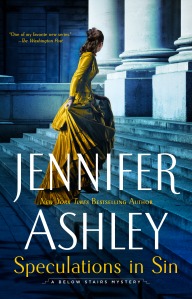 To save an innocent man’s life, amateur sleuth and cook Kat Holloway must expose a financial scam that could ruin the most powerful aristocrats in Victorian-era London, from the New York Times bestselling author of The Secret of Bow Lane.
To save an innocent man’s life, amateur sleuth and cook Kat Holloway must expose a financial scam that could ruin the most powerful aristocrats in Victorian-era London, from the New York Times bestselling author of The Secret of Bow Lane. It’s Lights, Action, Murder as tea maven Theodosia Browning scrambles for clues in this latest installment of the New York Times bestselling series.
It’s Lights, Action, Murder as tea maven Theodosia Browning scrambles for clues in this latest installment of the New York Times bestselling series. I love the theatre, so it’s not surprising that Murder in Masquerade features Royal Theatre, Drury Lane in London. I still recall my audible gasp when I saw the phantom dangling from the chandelier in Phantom of the Opera at the Orpheum Theatre in Minneapolis. How did he get up there, and how had I missed his climb? I’d been completely immersed in the story.
I love the theatre, so it’s not surprising that Murder in Masquerade features Royal Theatre, Drury Lane in London. I still recall my audible gasp when I saw the phantom dangling from the chandelier in Phantom of the Opera at the Orpheum Theatre in Minneapolis. How did he get up there, and how had I missed his climb? I’d been completely immersed in the story.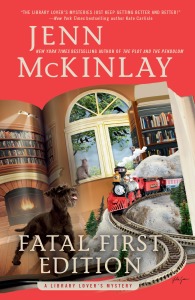 FATAL FIRST EDITION by Jenn McKinlay
FATAL FIRST EDITION by Jenn McKinlay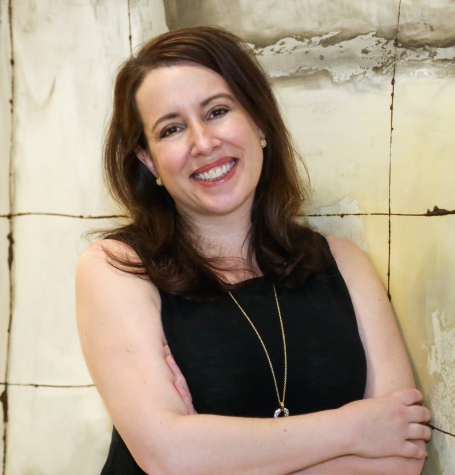
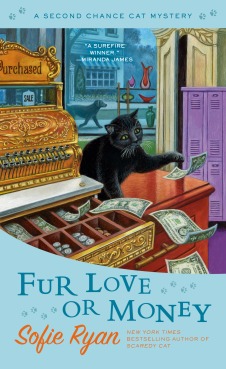 I’ve heard several different stories about the origin of the Chinese Zodiac, but my favorite comes from a guide we met in southern China. As the story goes, the Jade Emperor decreed that the years on the calendar would be named for the animals that had taken part in the Great Race, each one’s place determined by the order in which they reached the emperor. The trek included crossing a river. The cat and the rat hitched a ride on the back of the ox, who, it turned out, was very good-natured. (As someone who met several oxen in China, that’s not how I would describe them!) Just before they reached the other side, the rat pushed the cat into the water, where it drowned. That’s why cats loathe both rats and water to this day. And why there is no cat in the Chinese Zodiac.
I’ve heard several different stories about the origin of the Chinese Zodiac, but my favorite comes from a guide we met in southern China. As the story goes, the Jade Emperor decreed that the years on the calendar would be named for the animals that had taken part in the Great Race, each one’s place determined by the order in which they reached the emperor. The trek included crossing a river. The cat and the rat hitched a ride on the back of the ox, who, it turned out, was very good-natured. (As someone who met several oxen in China, that’s not how I would describe them!) Just before they reached the other side, the rat pushed the cat into the water, where it drowned. That’s why cats loathe both rats and water to this day. And why there is no cat in the Chinese Zodiac.